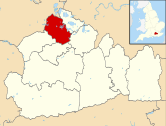Chertsey railway station
Chertsey railway station serves the town of Chertsey in the Runnymede District of Surrey, England. It is located on the Chertsey Loop Line and is operated by South Western Railway.
| Chertsey | |
|---|---|
 | |
| Location | |
| Place | Chertsey |
| Local authority | Runnymede |
| Grid reference | TQ037664 |
| Operations | |
| Station code | CHY |
| Managed by | South Western Railway |
| Number of platforms | 2 |
| DfT category | D |
| Live arrivals/departures, station information and onward connections from National Rail Enquiries | |
| Annual rail passenger usage* | |
| 2014/15 | |
| 2015/16 | |
| 2016/17 | |
| 2017/18 | |
| 2018/19 | |
| History | |
| 14 February 1848 | Opened |
| 1 October 1866 | Resited on the opposite site of the road |
| National Rail – UK railway stations | |
| |
The station was opened by the London and South Western Railway, with the initial section of the Chertsey branch line, in 1848. The existing building, now a Grade II listed building, was opened on 1 October 1866. It comprises Up and Down platforms having brick buildings: the main building being on the Down side. There is a level crossing here.
Local mythology ascribes the design of the existing station building to William Tite but, in fact, he had stopped all architectural work about 13 years previously. Historic England says, on this subject, "design thought to have been derived from earlier prototypes by Sir William Tite for L.S.W.R." citing, as its source, the book Victorian Stations: Railway Stations in England and Wales, 1836-1923 by Gordon Biddle 1973.
The station featured prominently in the seventh and last series of Public Eye (TV series) broadcast in 1975. In this series, the main character, private investigator Frank Marker rents and operates from a cheap cabin on the station forecourt, never bothering to change the lettering along the front from the Apollo Aerials sign which was there when he first came across the building.
Inside the station building was a café called the Buffet Carr which closed late 2009. A second unnamed café was operating at the station, which was replaced by Cravin' Coffee in late 2016.
Originally suited to serve up to 4-coach trains, an extension project that concluded in 2017 extended both platforms to serve up to 12-coach trains.
Original Station
Whereas the current station is about 40m to the north west of Guildford Street, the original 1848 station was on the other side of Guildford Street to the south east. At the time it opened and for 18 years thereafter, the line terminated at Guildford Street and the branch line ran only in a south easterly direction to Weybridge railway station. It was only with opening of the current station in 1866 that the line was completed north westwards to Virginia Water railway station in order to allow travel onward to Egham railway station and Reading railway station. The original station building was on the north eastern side of the tracks.
Plans showing the layout of both stations are available for viewing, by prior arrangement, in the research section of Chertsey Museum. An 1848 plan shows the original station at the time it was built. Plans from 1870-1880 show the current station with new buildings springing up around it but still using the sidings, goods warehouse and engine house on the other side of Guildford Street left over from the original station.
Services
There are trains every 30 minutes, westbound to Staines, Hounslow and London Waterloo, and eastbound to Weybridge.
| Preceding station | Following station | |||
|---|---|---|---|---|
| Virginia Water | South Western Railway Chertsey Branch |
Addlestone | ||
External links
| Wikimedia Commons has media related to Chertsey railway station. |
- Train times and station information for Chertsey railway station from National Rail
